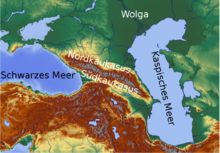Caucasus Mountains
![]()
The title of this article is ambiguous. For other meanings, see Caucasus (disambiguation).
dep1
p1
The Caucasus (Russian Кавказ, Kawkas; Georgian კავკასიონი, K'avk'asioni, Armenian Կովկաս, Kowkas, Azerbaijani Qafqaz, Turkish Kafkas, from Ancient Greek Καύκασος) is a high mountain range in Eurasia between the Black Sea and the Caspian Sea, about 1100 kilometres long, running from west-northwest to east-southeast. It is part of the Alpid mountain system and is divided into three mountain ranges, the Greater Caucasus, the Lesser Caucasus, and the Talysh Mountains. The Caucasus rises to a height of 5642 meters above sea level and has an average altitude of 602 meters. It is located on the territories of Russia, Georgia, Armenia, Iran and Azerbaijan. In 2000, about 30.6 million people lived in this mountain range and its vicinity. The region of the Caucasus has been an important hub for trade since ancient times.
Location and geography
→ Main article: Greater Caucasus and Lesser Caucasus
The Caucasus is divided into the plains of the North Caucasus, the Great Caucasus, the Transcaucasian Depression, the Little Caucasus and the Talysh Mountains. Drainage is predominantly radial. Longitudinal valleys are rare in the Caucasus. One of the few exceptions is the high valley of Svanetia.
The Great Caucasus is over 1100 kilometers long, up to 180 kilometers wide and in many ways indented. In the very north is the chain of forested Black Mountains (around 600 m). South of it follows the Pasture Ridge (1200 m to 1500 m), then the Rock Ridge (up to 3629 m). South of these ranges the mountain range is divided into four sections: the western Black Sea Caucasus, also called the Pontic Caucasus (600 m to 1200 m), the glaciated High Mountain Caucasus with the highest peaks Elbrus, Shchara and Kazbek (up to 5642 m), in the middle the Surami Mountains (up to 1926 m) and in the east the Caspian Caucasus (500 m to 1000 m). The main range is divided into two halves only by a single, year-round crossing, the Georgian Army Road. The Taman Peninsula and the Abşeron Peninsula form geological continuations of main or secondary ranges, which thereby still extend into the sea. With the Crimean Mountains and the Turkmen-Khorasan Kopet-Dag, the Great Caucasus lies on a folding zone of the Alpidic mountain building, to which, however, it does not border geographically, but is connected by submarine or still relatively shallow fold ridges.
About 100 kilometers to the south lies the Small Caucasus on the territory of Georgia, Armenia and Azerbaijan. The Small Caucasus is not an independent mountain range, but a section of the North Anatolian-North Iranian chain mountains with ceiling construction and young volcanoes. In the southwest it is connected with the Pontic Mountains in the Georgian-Turkish border area, in the southeast the Talysh Mountains on the territory of Iran merge into the Elburs Mountains, and in the south the Armenian Highlands join them. At the Surami Mountains it borders directly on the Great Caucasus. The highest mountain of the Small Caucasus is the Aragaz (4090 m). Gjamysh (3724 m) is also important as a reference mountain. It is covered with firn, but has no glaciers.

North and South Caucasus
Inner Eurasian border
In ancient times, the Caucasus was at times considered the border between Europe and Asia. Since 1735, according to Philipp Johann von Strahlenberg, in the Russian Empire, and later in the USSR, the Kuma-Manych lowland, located about 300 km north of the Great Caucasus, was considered the border between the continents. This representation is also mostly accepted internationally. Since the Caspian Sea was connected with the Black Sea from the Quaternary until about 10,000 years ago (Khalynsk Transgression), the former waterway forms a logical extension of the demarcation between Europe and Asia formed by the Sea of Azov - Black Sea - Bosporus - Sea of Marmara and Dardanelles. In the Great Soviet Encyclopedia, until the last edition, the continental border was still entered after Strahlenberg. Today, the Caucasus ridge is also considered a continental boundary in Russia.
Search within the encyclopedia